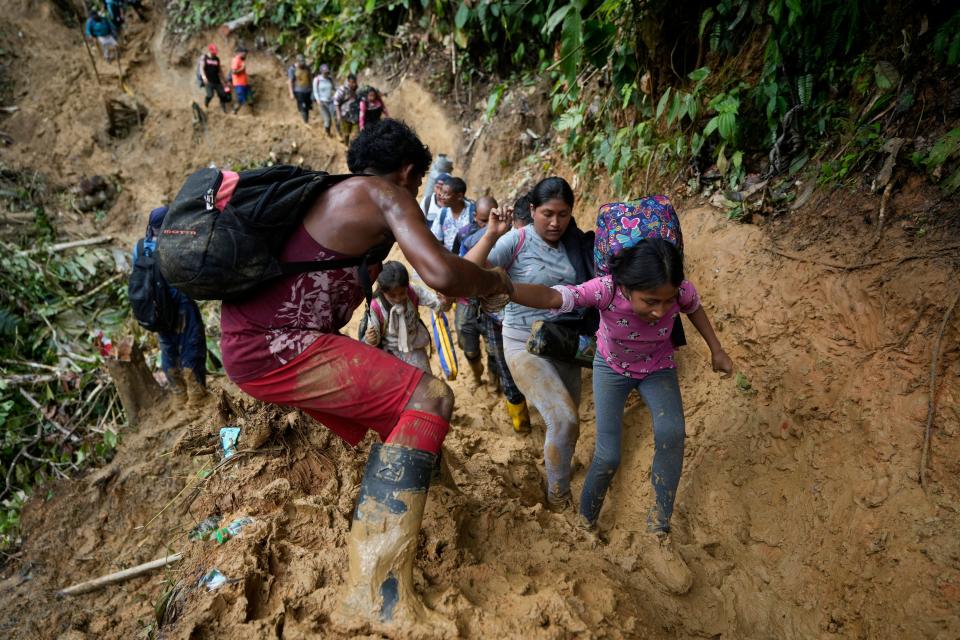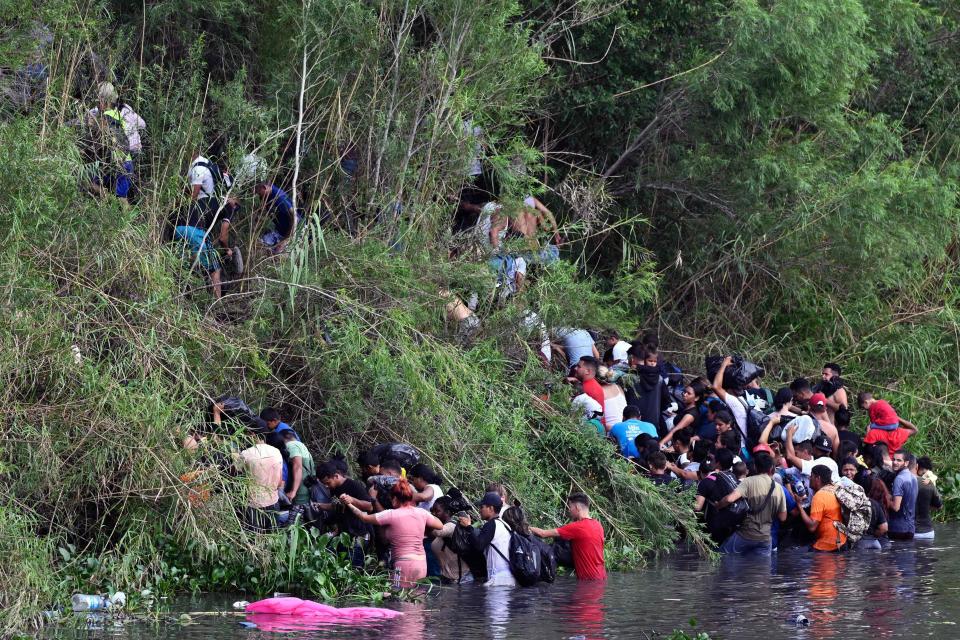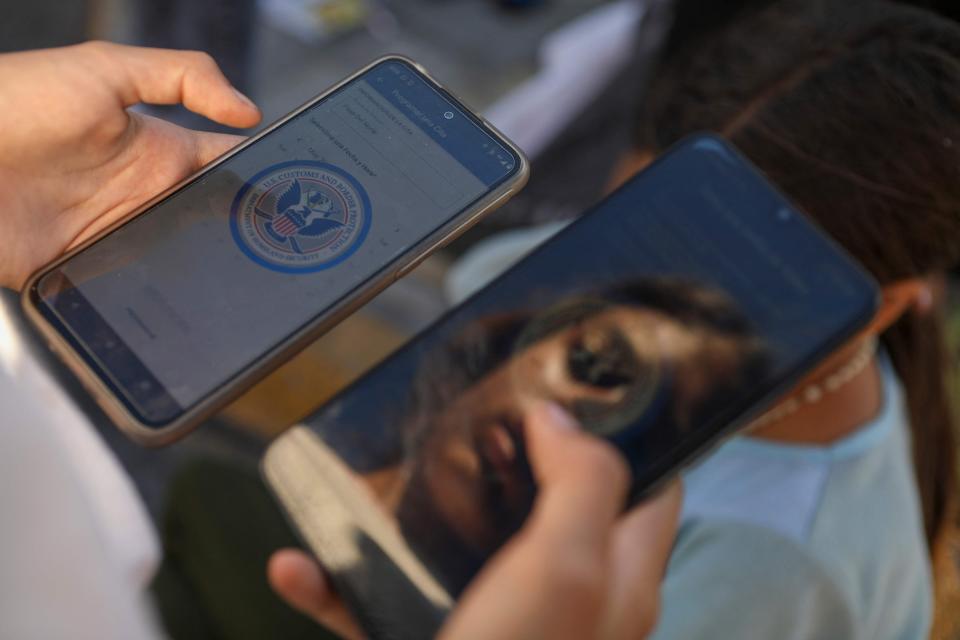'Deadly risks': Migrants use TikTok to share journey to southern border. But smugglers use it too
There are two things Hernan Vergel recommends when planning to cross the U.S. southern border: Bring a camping tent, and don't trust others.
These tips can be lifesaving, especially for migrants starting from the Darien Gap from Colombia into Panama, where animals can attack during humid nights.
But unlike other young users uploading the latest lip sync or spicy food challenge, Vergel, 34, has taken to TikTok every day since May 19 to document his journey to the U.S.-Mexico border. His videos explain how to safely cross Honduras without being bothered by authorities and how to shirk migration controls in Guatemala.
He isn't the only one. Smugglers are taking to TikTok to advertise their services, too.
Authorities and advocacy groups worry that social media platforms like TikTok are being used to encourage the perilous trek while minimizing the risks involved. Almost 2 million people try to cross the U.S.-Mexico border each year. Tens of thousands are kidnapped, abused and extorted by drug cartels running the smuggling routes just feet away from the U.S. Some migrants don't survive the journey as a result of hazardous conditions such as blistering heat and rough terrain.
A review by USA TODAY identified at least 15 out of dozens of accounts that use hashtags such as #Sue?oAmericano, #tapondarien, or #cbp, where anyone can browse through hundreds of videos with tips on how to cross the U.S. southern border ? or whom to hire. As of June, the hashtag #darien had been viewed 1.1 billion times.
USA TODAY was able to reach a user of these accounts as well as a man who described himself as a "coyote" – the Spanish slang word for smuggler – who agreed to speak on the condition of anonymity.
The man, who said he is from Central America but would not provide the country in which he lives, said he facilitates travel for migrants across the border in exchange for money.
The United Nations International Organization for Migration has warned about the dangerous trend.
"The TikTok platform is used to promote the 'services' offered by human traffickers through short videos. These videos showcase successful cases of irregular border crossings and captivating images aimed at capturing the attention of individuals seeking to migrate irregularly with the assistance of a third party," according to an IOM report that mapped the use of different social media platforms on human trafficking to the U.S.
TikTok did not respond to USA TODAY's multiple requests for comment for this story. The social media platform has also come under fire in recent months for other security concerns among teens and young users on the app.
'Too early': Mayorkas warns surge of migrants at southern border post-Title 42 is still possible

Documenting his journey on TikTok
Vergel spent his second night with an old man after his tent was stolen.
He began his trek in his native Colombia. Vergel said he was struck by how many people were gathered at the Darien Gap, the remote, roadless crossing that connects Central and South America and is made up of dense rainforest and steep mountains. He estimated there were hundreds, or even thousands, of people of different nationalities and ages, from newborns to elderly people carrying walking sticks.
Guides took them to a summit coined "Cima de las Banderas," or Flags Hill in English, because migrants plant flags from their home countries on the ground. After that, they are on their own. No one helps anyone, not even relatives, Vergel said.
Vergel said he believed that being in his mid-30s would make it easier to climb muddy mountains and hills along the way. The trip was like a video game, where migrants are guided by a path made of blue plastic bottles and cross from one rock to another, either jumping or using vines.
What to know: What is Title 42, when does it end, how does it impact US-Mexico border?
But there are no second chances.
"It is very difficult, but unless you are in that moment, experiencing it firsthand, you won't feel the pain and fatigue of climbing those summits," Vergel said.
He had to stop for half of his first day to avoid drowning in a rushing river that was rapidly increasing due to heavy rain. He found shelter in his tent. Others were not as lucky. Later that day, he heard stories of people who died, suffered bone fractures or went missing.
"People on this route face deadly risks related to their transit through inhospitable topography and natural barriers characterized by large rivers, flash floods, dense foliage, and wild animals," the IOM warned.
Between January and April, at least 127,687 people, mostly adults, crossed this jungle route. Most were from Venezuela, Haiti and Ecuador, according to Panamanian authorities.

In Vergel's case, he has crossed not only Panama but Costa Rica, Nicaragua, Honduras, Guatemala and part of Mexico. His more than 10,000 followers are constantly reaching out to him, to seek advice on the journey and wish him safe travels.
Vergel said one of the worst parts of his journey was a five-hour boat ride to a migrant camp on Panama's border. He was thirsty and had a high fever, headache and sunburn. When the boat arrived, there was a 200-person line for emergency cases, but he wanted to keep going.
Now, he hopes his sacrifice will be worth it.
Washington: Marjorie Taylor Greene silenced by committee after calling DHS Secretary Mayorkas 'a liar'
Public smuggling activity
Social media and other online platforms have increased smugglers' access to migrants, "creating an environment ripe for the manipulation of information regarding migration policies at the border," said the U.S. Department of Homeland Security in a statement to USA TODAY.
Videos and accounts promoting smuggling have spread on TikTok. Some smugglers present themselves as safe travel agencies, promising a low possibility of failure if migrants travel with them, based on USA TODAY's review of these posts.
To gain trust, they record and post video testimonials of purported clients who appear to have arrived safely in the U.S.
The man who described himself as a coyote from Central America claimed to know the safest way to cross the U.S. border without being caught. However, the cost could be as high as $10,000 if the journey starts from Guyana.
The man said he has contacts along different routes and in multiple countries to "protect" migrants. He refers to his illegal enterprise as an "agency" that transports migrants to the U.S. border. He said he uses private cars, buses, vans and boats, providing accommodation and documents to ensure a safe journey. He said he maintains constant communication with the migrants' relatives.
The man painted a rosy picture of his operation, saying that he and his associates provide hotels and food as part of his service. Meals could often include rice, meat, salad, eggs, bread and bananas, he said.
That isn't the reality for many migrants. Some border crossers are found lost, disoriented and dehydrated in the desert sun. Smugglers have accidents or abandon migrants. Last fiscal year, at least 853 migrants died trying to enter the U.S. illegally, making it the deadliest year recorded by the U.S. government, according to data obtained by CBS from U.S. Customs and Border Protection.
“Transnational criminal organizations continue to recklessly endanger the lives of individuals they smuggle for their own financial gain with no regard for human life,” CBP said in a statement. “Smuggling organizations are abandoning migrants in remote and dangerous areas, leading to a rise in the number of rescues but also tragically a rise in the number of deaths. The terrain along the border is extreme, the summer heat is severe, and the miles of desert migrants must hike after crossing the border in many areas are unforgiving.”
When asked by USA TODAY why he wasn't afraid of using TikTok to promote illegal activities, the coyote replied that other people use social media platforms to offer illegal services. Often, no one pays attention to those cases.

"Those who operate in the shadows or do their job poorly do not use social media; they use other methods to steal or kidnap migrants. ... Our intention is precisely to find ways to prevent them from being harmed," the smuggler said.
American officials have warned migrants about working with smugglers to try to enter the U.S. illegally.
Secretary of Homeland Security Alejandro Mayorkas earlier this year said, "Those who arrive at our border and do not have a legal basis to stay will have made the journey, often having suffered horrific trauma and having paid their life savings to the smugglers, only to be quickly removed."

Dangerous viral content TikTok
According to the Washington Office on Latin America, a human rights research and advocacy group, the use of TikTok to facilitate illegal migration creates an “information vacuum" and fuels rumors, which spread quickly now that most migrants have smartphones with internet access. “In the fight to provide information to migrants, social media acts as a pipeline, while the government's efforts are limited," the group said.
WOLA says American immigration policy has played a role in this spread online.
"The increased use of the TikTok app is a symptom of the terrible job that the U.S. and all governments along the migration route do in warning about the dangers (let alone addressing them)," the group told USA TODAY.

Catholic Relief Services, a nonprofit that provides support to thousands of displaced people, also expressed concern about the misinformation migrants face during their journey.
"Smugglers and those who take advantage of migrants' desperation are using social media to offer highly risky services that endanger their lives," Miguel Meza, the group's migration program officer for Mexico and Guatemala, told USA TODAY in a statement. He added that part of the help they offer migrants includes legal advice in shelters so they can make informed decisions that "protect their well-being."
Meza emphasized the need for migrants to access reliable information from official sources such as United Nations High Commissioner for Refugees, International Organization for Migration and U.S. Citizenship and Immigration Services.
The U.S. Department of Homeland Security launched a digital advertising campaign last month to inform potential migrants that U.S. immigration laws under Title 8 are tougher.

"The Coyote swindled us. Entering the USA illegally is a crime. Say no to the coyote" is splashed across one of the ads.
USA TODAY contacted TikTok to inquire about whether it knew its platform was being used to promote illegal migration and human smuggling. USA TODAY pressed TikTok on whether the platform was taking measures or planning steps to identify and remove such content and if there was any existing collaboration with law enforcement.
Members of TikTok's global safety and policy communications team replied to an email asking USA TODAY for more information on these accounts. As of June 6, USA TODAY confirmed that those accounts had been banned and USA TODAY's questions remain unanswered.
But for every account banned, a new one surfaces. More worrisome is the fact that many migrants are still turning to social media for guidance about crossing the U.S. southern border despite the risks.
The last time USA TODAY reached out to Vergel on June 2, he said he was in Mexico, roughly 2,600 miles away from the U.S. border. After more than 38 days since leaving Colombia, he advised that if he couldn't be contacted, he might have been arrested.
"If you don’t see me again here, it is because I have been arrested by migration officers," he said. "It is riskier from this point on."
He'd also run out of money and wasn't quite sure how he'd come up with the cash to keep heading north.
For tonight, though, he'd retired his tent for a spot in a shelter.
Carolina Pichardo Hernández is an International Center for Journalists and USA TODAY fellow based in the Dominican Republic. You can find her on Twitter @caropichardoh and Instagram @carolinapichardoh
This article originally appeared on USA TODAY: Migrants – and smugglers – share their journey to the border on TikTok
